But here's what you've missed.
The Longridge Restaurant isn't exactly where it all started for Paul Heathcote (previously there had been at least Smithalls at Bolton, Sharrow Bay, the Connaught, and the Broughton Park Hotel near Preston), but it's where he started on his own, collecting two Michelin stars and an empire of restaurants across the north west. The stars went as the empire grew, and then the recession did for the empire, and the business is now wisely retrenched to the two original sites, with two restaurants on the Winckley Square site in Preston and here at the flagship, Longridge Restaurant.
Chris Bell had been doing good work in the kitchen until earlier this year when he was lured back to his native Northern Ireland. Hywel Griffith is now installed as Head Chef and continuing to raise the game at Longridge. I actually went (entirely coincidentally) on his first day, but, although it was a good meal, it seemed unfair to report on it when he'd only walked through the door a few hours previously.
Normally a Christmas lunch menu is not a good one to report on either, but this was good enough, and representative enough to overcome such scruples.
Three courses for £23 is a good deal, and combined with no booze at all due to to fears of random breath testing, it was an extremely good value lunch, especially for the quality.
With the menus, come some impressive canapés: a black olive palmier is jolly good, but entirely in the shade of a parmesan marshmallow.
That marshmallow must be one of the best canapés in the country at the moment: it's as light as air, but packing a rich, savoury, umami-laden flavour. Genius.
It is worth going just to have the marshmallow.
Bread has always been a strong point at Longridge, and continues to be. Dinky little brioches, good wholemeal rolls, but the star is the white roll flavoured with caraway seed, reminiscent of the famous, and highly localised, Goosnargh cakes down the road where the chickens, turkeys etc come from.
The Jerusalem artichoke velouté was a good example, perhaps a little underseasoned/underpowered, with crosnes among the other decorations. It was, however, disappointing that the (soft boiled) quail's egg was cold and I couldn't really detect any tea flavours.
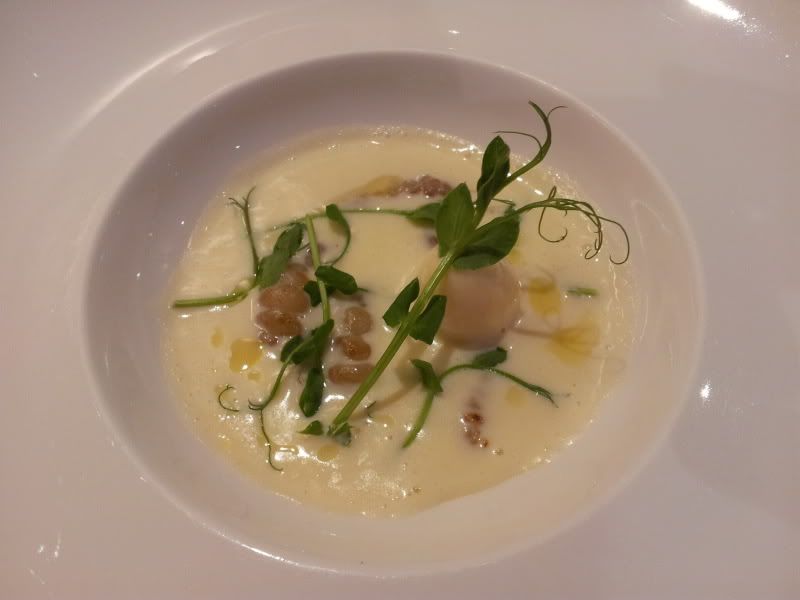 |
| Jerusalem artichoke velouté, lapsang and quail egg |
When it arrived, I thought it was a bit of a small portion. While it's true that you can never have too much pig on your plate, the portion size was bang on in the context of the meal.
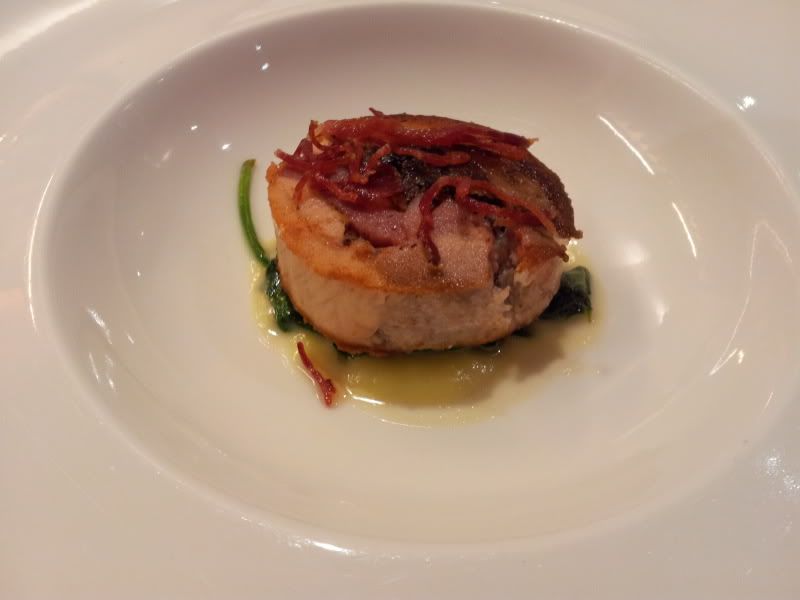 |
| Pressing of local pork: belly, hock, cheek, chorizo and apple sauce |
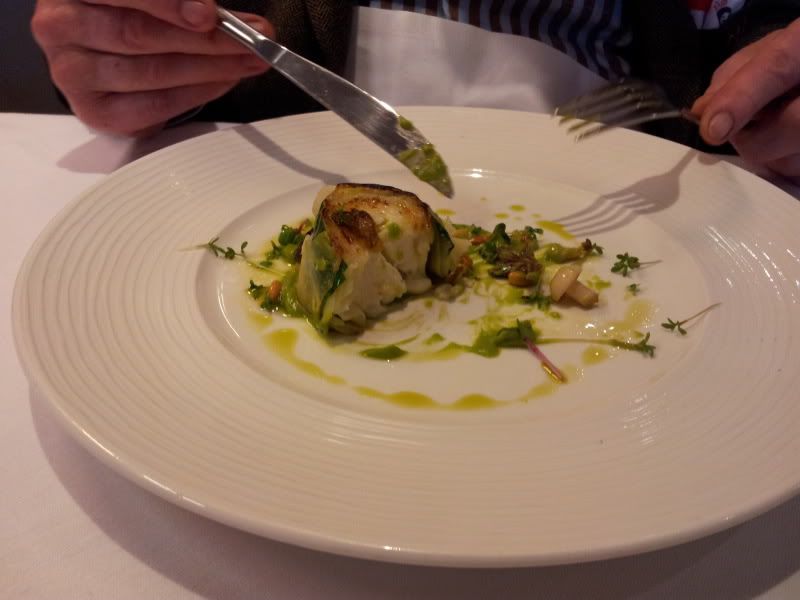 |
| Mozzarella and celeriac roulade, wild mushrooms, broccoli purée and basil oil |
Braised oxtail dumpling turned out to be a suet pudding. Most forms of suet pudding are usually substantial, but this one turned the norm on its head, with a very thin crust and lots and lots of meat inside. The meat itself could, perhaps, have been a little more aggressively seasoned, but in combination with the sweet, ultra-smooth (hello, Thermomix) carrot purée and a classic Madeira jus, they got away with it.
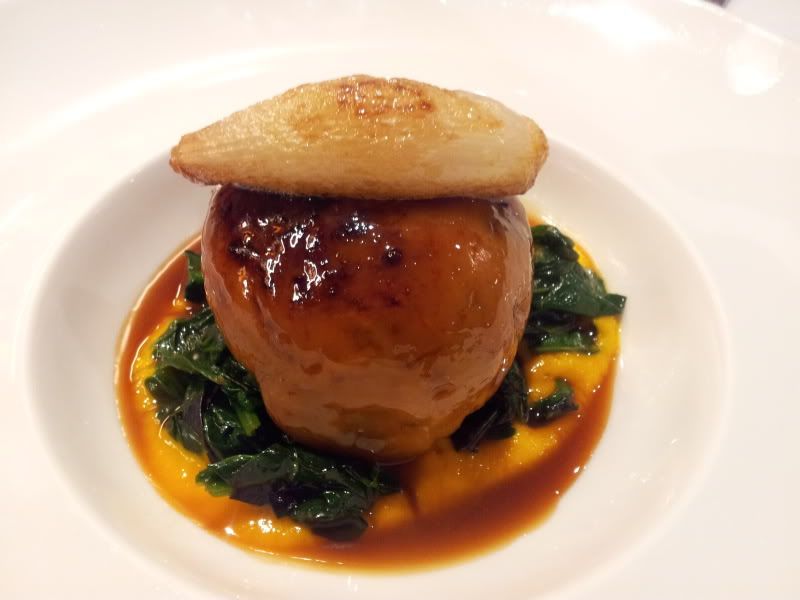 | ||
| Braised oxtail dumplings, carrot purée, roasted shallot and Madeira jus | (doing an impression of Andy Capp) |
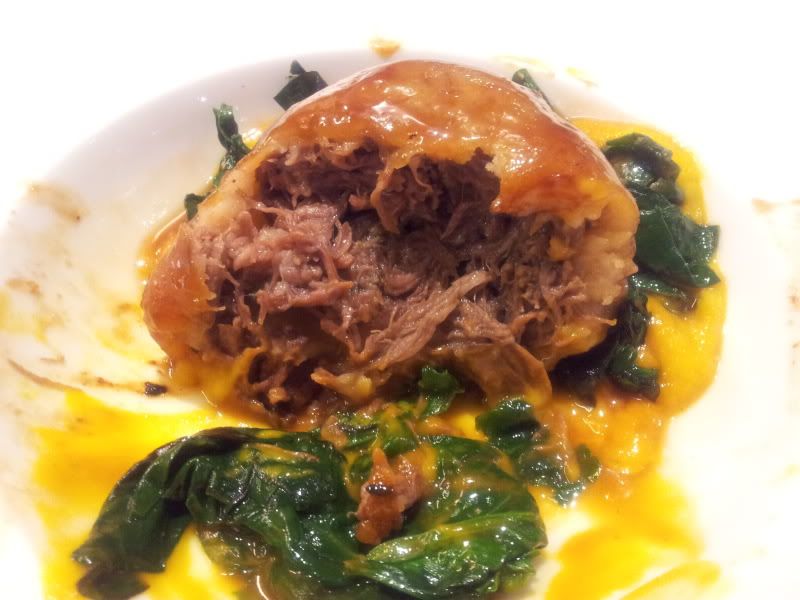 |
| the interior of the oxtail dumpling |
Halibut is not my favourite fish, and this smallish piece of halibut, which suffered a bit from slightly uneven cooking (not quite sure how they managed that), didn't convert me. But that didn't spoil the dish for me as a whole, with the different types of sweetness of the scallop, the shrimps and the onion purée working together with the fish. No problem with seasoning on this dish at all.
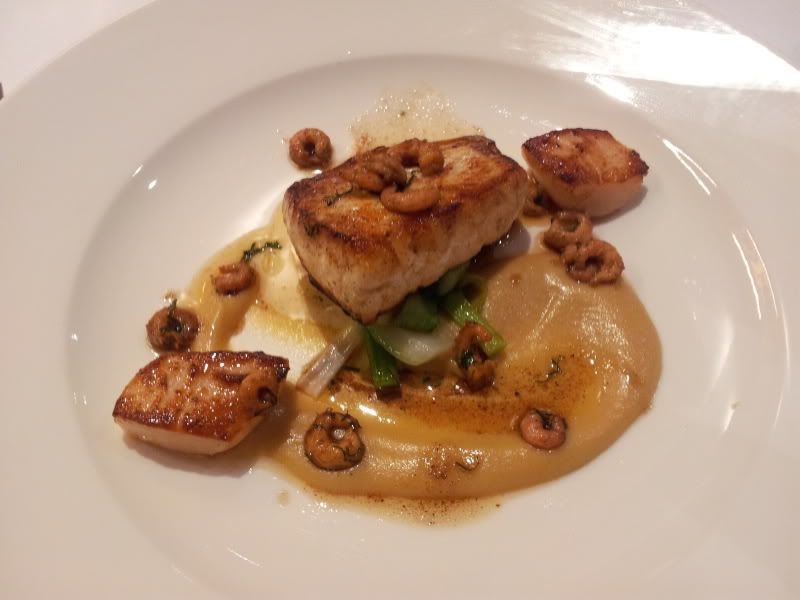 |
| Seared halibut, king scallops, onion purée and brown shrimp butter |
The traditionalist at the table had the turkey, which was, well, turkey. A tronçon of the breast which really did need more seasoning came with a small pie made with very good short pastry and containing confit of the leg with sage. The sage was a little too dominant, but in the context of the whole dish, the powerful sage and onion of the pie balanced the under-seasoning of the breast.
Homemade Christmas pudding was a good pudding, quite possibly more fruit than pudding and lots of foamy brandy sauce. Again, one for the traditionalist. Not for me. Like all Christmas puddings, a bit too heavy at the end of a meal.
A vanilla parfait, filled with glacé fruit was literally exemplary stuff: an exemplar of its type, showing a confident hand in the pastry section, as did its accompanying mulled wine sorbet, which managed to avoid over-winey-ness or over-spicing. Nothing to complain about with the accompanying cherry purée and jelly, though they somewhat got lost next to the brilliance of the parfait and sorbet.
 |
| Vanilla and glacé fruit parfait, mulled wine sorbet, cherry purée and jelly |
Rhubarb crumble with custard and mince pie ice cream sounded pretty straightforward, but was rather more involved on the plate. Again, this was a really excellent dish, let down only by the plating, I think. And not even the plating, but rather the plate itself, which just seemed a bit utilitarian and clumsy for what was actually a very refined dish.
 |
| Rhubarb crumble, toasted oats, mince pie ice cream and custard |
Poached rhubarb, a rhubarb parfait, rhubarb purée with vanilla pannacotta(?) forming the custard. I would happily have taken away a litre of the rather gorgeous mince pie ice-cream. The shard of shortbread in the middle of the plate deserves special menu. Somebody in the kitchen has a really good hand with all sorts of pastry. Ultra-short and buttery, it defied being picked up without breaking.
The pastry excellence continued with the petits fours, which were some quite remarkable small mince pies: open tarts with a blob of frangipane on top of the mincemeat. But it's the pastry that took your breath away: it was as thin as paper, yet also remarkably short. My guess is that they were slightly overbaked (the colour of the pastry suggested this) to help them hold up: otherwise, it's quite difficult to understand the engineering, as they shouldn't have been able to hold the filling, let alone hold up to being picked up.
Still room for improvement in the coffee department though. But 'twas ever thus.









